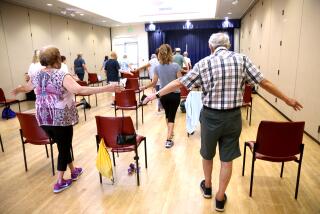Decor Matures With Personal Needs
- Share via
Decorating tastes often change as people age. And decor often needs to be modified because of physical changes related to vision, physical agility and hearing.
Don’t necessarily think of these changes as a negative.
“It is better here than in our house where we lived for 28 years, and the bathroom is a dream,” said Paul Bischoff, the interior design consultant at Lake Forest Place, a retirement community in Lake Forest, Ill. Bischoff and his wife, Wy, who is also an interior designer, recently moved to a retirement community.
“We are almost completely on one floor here in case one of us should ever need a wheelchair,” Bischoff said.
In designing the public areas for Lake Forest Place, he was mindful that “older people generally like familiar surroundings, so interiors should be warm and friendly and comfortably traditional.”
Bischoff made sure that visual “barriers”--such as a heavy dark line in light-colored carpet--were eliminated. Although not a physical impediment, such a line “can cause older people to come to a complete stop,” he said.
In making the move, the Bischoffs kept most of their furniture.
But it is often a good idea to replace deep, soft seating with something more shallow and firm.
“It’s hard to get in and out of deep pieces, and down filling is too soft for many older people,” said Dale Miller, an interior designer in Boca Raton, Fla. “A wingback chair is ideal because it’s upright, the arms are firm, and the wings buffer annoying sounds.”
“Many older people become less spry and need to use their furniture to raise and lower themselves,” said Miller, who specializes in projects for seniors.
Since glare is irritating to aging eyes, Miller avoids overly shiny schemes and places lamps so they don’t shine into someone’s eyes. Besides draperies, she often uses window blinds to control sunlight.
Miller also has these tips:
* Arrange furniture to allow space to easily avoid obstructions.
* Use three-way bulbs in lamps or replace bulbs with stronger ones.
* Place nonskid pads under area rugs.
The right color scheme can contribute to an overall sense of well-being. High-contrast color schemes are best for seniors because “similar colors blend into one another, and you can’t tell where one color ends and the other begins,” Miller said.
She suggests peach or rose with green, burgundy with green and yellow, or deep emerald green and rose accented with gold or yellow.
Since background noises can be annoying as one ages, draperies and carpeting are good decorating choices. Soft carpeting is good, in case someone trips. But low-pile carpet is better for someone using a walker or is in a wheelchair.


